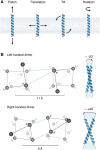Membrane receptor activation mechanisms and transmembrane peptide tools to elucidate them
- PMID: 31879273
- PMCID: PMC7029107
- DOI: 10.1074/jbc.REV119.009457
Membrane receptor activation mechanisms and transmembrane peptide tools to elucidate them
Abstract
Single-pass membrane receptors contain extracellular domains that respond to external stimuli and transmit information to intracellular domains through a single transmembrane (TM) α-helix. Because membrane receptors have various roles in homeostasis, signaling malfunctions of these receptors can cause disease. Despite their importance, there is still much to be understood mechanistically about how single-pass receptors are activated. In general, single-pass receptors respond to extracellular stimuli via alterations in their oligomeric state. The details of this process are still the focus of intense study, and several lines of evidence indicate that the TM domain (TMD) of the receptor plays a central role. We discuss three major mechanistic hypotheses for receptor activation: ligand-induced dimerization, ligand-induced rotation, and receptor clustering. Recent observations suggest that receptors can use a combination of these activation mechanisms and that technical limitations can bias interpretation. Short peptides derived from receptor TMDs, which can be identified by screening or rationally developed on the basis of the structure or sequence of their targets, have provided critical insights into receptor function. Here, we explore recent evidence that, depending on the target receptor, TMD peptides cannot only inhibit but also activate target receptors and can accommodate novel, bifunctional designs. Furthermore, we call for more sharing of negative results to inform the TMD peptide field, which is rapidly transforming into a suite of unique tools with the potential for future therapeutics.
Keywords: T-cell receptor (TCR); cell signaling; conformational change; epidermal growth factor receptor (EGFR); integrin; oligomerization; protein–protein interaction; receptor tyrosine kinase; transmembrane domain; transmembrane receptor; α-helical.
© 2020 Westerfield and Barrera.
Conflict of interest statement
The authors declare that they have no conflicts of interest with the contents of this article
Figures




References
Publication types
MeSH terms
Substances
Associated data
- Actions
- Actions
Grants and funding
LinkOut - more resources
Full Text Sources
Research Materials
Miscellaneous

